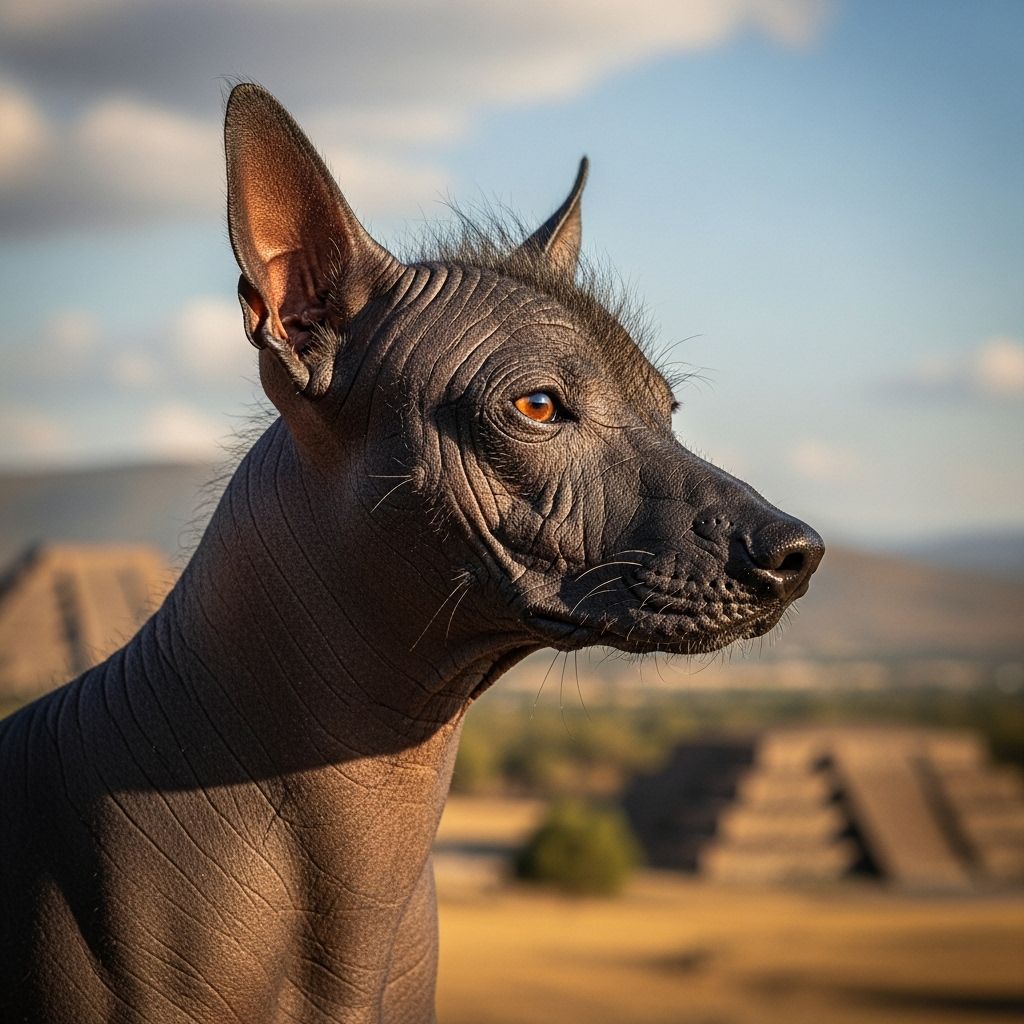Xoloitzcuintli: The Ancient Mexican Hairless Dog Breed Guide
An alert companion whose loyalty and calm presence enhance every moment at home.

The Xoloitzcuintli, also known as the Mexican Hairless Dog or simply Xolo, is one of the world’s oldest and most intriguing dog breeds. Revered in its native land of Mexico for thousands of years, the Xolo is celebrated for its loyalty, intelligence, and striking hairless appearance. In this comprehensive guide, we’ll explore the breed’s origins, temperament, appearance, care requirements, and provide essential tips for prospective and current owners.
Breed Overview
| Breed Name | Xoloitzcuintli |
|---|---|
| Alternate Names | Mexican Hairless Dog, Xolo |
| Origin | Mexico |
| Height | Toy: 10–14 in; Miniature: 14–18 in; Standard: 18–23 in |
| Weight | Toy: 10–15 lbs; Miniature: 15–30 lbs; Standard: 30–55 lbs |
| Lifespan | 13–18 years |
| Coat | Hairless or coated varieties |
History and Origins
The Xoloitzcuintli traces its roots back over 3,000 years to ancient Mexico. Its name comes from two Nahuatl Aztec words: Xolotl, the god of fire and lightning, and itzcuintli, meaning dog. The breed was considered sacred by the Aztecs, Toltecs, Mayans, and other Indigenous peoples. Xolos were often depicted in ancient pottery and carved statues, believed to have spiritual significance as guides for souls in the afterlife and protectors against evil spirits.
- Xoloitzcuintlis were domesticated by Aztecs along with turkeys, one of the only two animals they are known to have tamed.
- Xolos have a longstanding association with healing, warmth, and spiritual well-being. Many people believed the breed could ward off evil and disease.
- The breed nearly vanished in the 20th century, but preservation efforts in Mexico rescued the Xolo from near extinction.
Physical Characteristics
The Xoloitzcuintli stands out for its elegant, sculpted appearance and naturally hairless skin, although coated varieties also exist. This breed comes in three sizes—toy, miniature, and standard—offering flexibility for varying lifestyles and living spaces.
Distinguishing Features
- Skin: Thick, tough, yet smooth; most commonly dark gray or black, but shades can vary.
- Ears: Large, upright, and bat-like—enhancing their alert look and keen hearing.
- Eyes: Almond-shaped, expressive, typically dark or matching the skin color.
- Body: Lean, athletic, well-muscled, not bulky; tail is long and thin.
- Coated Variety: Has a short, sleek coat instead of bare skin.
Xolos often change color as they mature, and some may have a few tufts of hair on the head or tail, especially in the hairless variety. Their skin is purposefully robust, offering more protection than seen in many other hairless breeds, which helps prevent injuries.
Temperament and Personality
Xoloitzcuintlis are renowned for their calm, intelligent, and deeply loyal personalities. These dogs form intense bonds with their families and are often described as ‘Velcro dogs’ because they prefer to be close to their favorite humans at all times.
- Loyalty: Xolos are extremely devoted, often attaching closely to one person but can bond with the whole family when properly socialized.
- Calm and Gentle: These dogs are serene and prefer tranquility, making them excellent companions for households seeking a peaceful atmosphere.
- Intelligent: Known for problem-solving and quick learning; eager to please with positive reinforcement.
- Alert but Not Aggressive: Xolos will bark to alert their family to anything unusual but are not prone to excessive barking or unprovoked aggression.
- Watchful: They make good watchdogs, though they are typically more reserved than threatening to strangers.
Early and consistent socialization is important, as Xolos can display wariness towards unfamiliar people if not properly exposed. Despite their intensity of feeling towards family, they are often not overly demonstrative in the cuddly sense, preferring to quietly remain by your side.
Living with a Xoloitzcuintli
Xolos adapt well to a variety of living environments, from apartments to homes with yards, as long as their social and exercise needs are met. Here’s what you should know about sharing your life with a Xolo:
- Preferred Environment: Does well indoors but should be protected from extreme temperatures, both hot and cold, due to lack of a fur coat.
- Good with Families: Especially attentive and gentle with children and family members; early training ensures a harmonious household.
- Activity Preferences: Loves to walk, play, and join in family activities but also enjoys lounging quietly at home.
- Travel: Generally adapts well to travel as long as allowed to be close to their primary person.
- Compatibility: Can coexist peacefully with other pets, especially if socialized early. May display a preference for human company or be selective in animal friendships.
Exercise Requirements
Xoloitzcuintlis have low to moderate exercise needs. While they enjoy regular activity, they are not hyperactive and do not require exhaustive routines. Meeting their needs usually involves:
- At least one daily walk, paired with some playtime (fetch, tug-of-war, or agility activities).
- Mental enrichment to prevent boredom—puzzle toys and varied training sessions are excellent choices.
- Safe, secure outdoor play areas if off-leash, as their nimble bodies and curiosity can lead them to explore.
Training and Intelligence
The Xolo’s intelligence and desire to please make them generally receptive to training. They are quick learners but may display some independence, requiring patient and positive approaches:
- Best results are achieved through gentle, positive-reinforcement techniques.
- Obedience, agility, and therapy work are activities where Xolos excel.
- Early socialization is recommended to foster confidence and prevent aloofness or shyness.
- Consistency among all family members in training and leadership encourages calm, balanced behavior.
Without sufficient stimulation—both mental and physical—Xoloitzcuintlis can become bored and may develop undesirable habits. They appreciate structure and respond well to purposeful activities.
Grooming and Skin Care
Grooming a Xoloitzcuintli is straightforward, especially for the hairless variety. However, their unique skin requires protection and simple routines:
- Bathing: Bathe the hairless Xolo every one to two weeks with a gentle, non-soap cleanser to remove dirt and prevent buildup.
- Skin Moisturization: Apply an unscented moisturizer recommended by your vet to prevent dryness, but avoid over-moisturizing which can clog pores.
- Sun Protection: Limit direct exposure to strong sunlight and use dog-safe sunscreen to prevent burns.
- Coated Variety: Brush occasionally to remove loose hair and debris.
- Nail Trimming and Ear Cleaning: Routine care is essential for healthy nails and ears.
- Check for Skin Issues: Regularly inspect for rashes, acne, or irritation. The skin is resilient but not invincible.
Health and Potential Concerns
Xoloitzcuintlis are generally robust, hardy, and long-lived. However, like all dog breeds, they are predisposed to certain health issues:
- Allergies: Xolos may develop skin allergies or sensitivities.
- Hip Dysplasia: Some lines may be prone, so responsible breeding and vet checks are crucial.
- Patellar Luxation: Common in many small to medium breeds; regular checkups detect early signs.
- Dental Care: Especially important for hairless Xolos, who may have missing or uneven teeth. Regular brushing and dental chews are advised.
- Injuries: Their thick skin provides some protection, but rough surfaces or sharp objects should be avoided.
Routine veterinary care, a balanced diet, and a stable, loving environment all contribute to the Xolo’s well-being and longevity—many live into their late teens when properly cared for.
Nutrition and Feeding
Xolos have moderate appetites and do well on high-quality, age-appropriate commercial or home-cooked diets. Nutritional needs may change based on life stage (puppy, adult, senior), activity level, and any health considerations.
- Ensure constant access to fresh water.
- Divide meals into two daily feedings to prevent overeating and bloating.
- Monitor treats and snacks to avoid unnecessary weight gain.
- Consult your veterinarian to tailor dietary choices to your dog’s individual requirements, particularly if food allergies or sensitivities arise.
Frequently Asked Questions (FAQs)
What is the difference between hairless and coated Xoloitzcuintlis?
Most Xolos are hairless, showing smooth, tough skin, while a minority are coated, with a short, sleek layer of hair. Both varieties share temperament and health profiles, though hairless dogs need extra skin care and sun protection.
Are Xoloitzcuintlis good for allergy sufferers?
The hairless variety is sometimes tolerated better by people with allergies due to minimal shedding and dander, but no dog is entirely hypoallergenic.
How much exercise do they need?
Xolos require at least a short daily walk and opportunities for play. They enjoy activity but do not need excessive or strenuous exercise to stay healthy and content.
Are Xolos good with children and other pets?
When properly socialized, they tend to be gentle and loyal with children and can get along with other pets. Supervision and training are key, especially with smaller animals.
What is their temperament with strangers?
They are often reserved but not aggressive; early exposure helps them remain polite and composed when meeting new people.
Is the Xoloitzcuintli a good watchdog?
Yes, Xolos are alert and will bark to warn their owners of unusual happenings, although they rarely exhibit aggressive guard behaviors.
Is the Xolo Right for You?
The Xoloitzcuintli is best suited to:
- People seeking a deeply devoted, intelligent, and calm pet.
- Homes willing to provide regular skin care and routine veterinary attention.
- Owners who enjoy a strong dog-human bond; Xolos thrive on companionship and do not do well left alone for long periods.
- Individuals seeking an ancient and unique breed with rich cultural heritage and history.
Quick Tips for Xoloitzcuintli Owners
- Prioritize gentle, positive training and early socialization.
- Implement a consistent grooming and skin protection routine.
- Monitor health, focusing on skin, joints, and dental care.
- Provide a stable, loving environment and avoid frequent, long separations.
- Embrace the breed’s quiet loyalty and unique charm!
Final Thoughts
The Xoloitzcuintli, with its striking looks, ancient roots, and gentle temperament, is a distinctive and rewarding companion. Whether you’re drawn to its history, rarity, or personality, this breed’s devotion earns it a special place among dog lovers worldwide. With the right care and environment, the Xolo can bring years of warmth and friendship to any home—quietly watching over its family with the same spirit that made it legendary throughout Mexico for centuries.
References
Read full bio of Srija Burman












